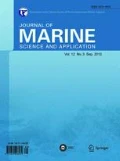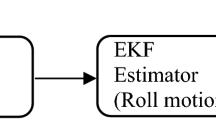Abstract
This paper investigates mathematical modelling of response amplitude operator (RAO) or transfer function using the frequency-based analysis for uncoupled roll motion of a floating body under the influence of small amplitude regular waves. The hydrodynamic coefficients are computed using strip theory formulation by integrating over the length of the floating body. Considering sinusoidal wave with frequency (ω) varying between 0.3 rad/s and 1.2 rad/s acts on beam to the floating body for zero forward speed, analytical expressions of RAO in frequency domain is obtained. Using the normalization procedure and frequency based analysis, group based classifications are obtained and accordingly governing equations are formulated for each case. After applying the fourth order Runge-Kutta method numerical solutions are obtained and relative importance of the hydrodynamic coefficients is analyzed. To illustrate the roll amplitude effects numerical experiments have been carried out for a Panamax container ship under the action of sinusoidal wave with a fixed wave height. The effect of viscous damping on RAO is evaluated and the model is validated using convergence, consistency and stability analysis. This modelling approach could be useful to model floating body dynamics for higher degrees of freedom and to validate the result.
Similar content being viewed by others
References
Baghfalaki M, Das S K, Das S N (2012). Analytical model to determine response amplitude operator of a floating body for coupled roll and yaw motions and frequency based analysis. International Journal of Applied Mechanics, 4(4), 1–20.
Baghfalaki M, Das S K (2013). Mathematical modelling of transfer function for roll motion of a floating body with an analogy to free damped vibration. International Journal of Theoretical and Applied Mechanics, 1(1), 1–13.
Clauss G, Lehmann E, Ostergaard C (1992). Offshore structures, Vol. 1 —Conceptual design and hydrodynamics. Springer-Verlag, London.
Cummins WE (1962). The impulse response function and ship motions. Schiffstechnik, 9, 101–109.
Das S N, Das S K (2005). Mathematical model for coupled roll and yaw motions of a floating body in regular waves under resonant and non-resonant conditions. Applied Mathematical Modelling, 29(1), 19–34.
Das S K, Das S N (2006). Modelling and analysis of coupled nonlinear oscillations of floating body in two degrees of freedom. Acta Mechanica, 181(1–2), 31–42.
Das S K, Das S N, Sahoo P K (2008). Investigation of coupled sway, roll and yaw motions of a floating body: Numerical modelling for non-linear roll restoring. Ships and Offshore Structures, 3(1), 49–56.
Das S N, Shiraishi S, Das S K (2010). Mathematical modeling of sway, roll and yaw motions: Order wise analysis to determine coupled characteristics and numerical simulation for restoring moment’s sensitivity analysis. Acta Mechanica, 213(3–4), 305–322.
Faltinsen OM, Newman JN, Vinje T (1995). Nonlinear wave loads on a slender vertical cylinder. J. Fluid Mechanics, 289, 179–198.
Frank W, Salvesen N (1970). The frank close-fit ship-motion computer program. NSRDC, Washington, DC, USA, Report No. 3289.
Froude W (1861). On the rolling ships. Institution of Naval Architects Transactions, 2, 180–229.
Holappa KW, Falzarano JM (1998). Application of extended state space to nonlinear ship rollin. Ocean Engineering, 26(3), 227–240.
Journée JMJ, Adegeest LJM (2003). Theoretical Manual of Strip Theory Program-SEAWAY for Windows, Amarcom, Dalfsen, Netherlands, Report NO. 1370.
Korvin-Kroukovsky B V (1955). Investigation of ship motions in regular waves. Trans. Society of Naval Architects and Marine Engineer, 63, 386–435.
Korvin-Kroukovsky BV, Lewis EV (1955). Ship motions in regular and irregular seas. International Shipbuilding Progress, 2, 81–95.
Newman JN (1977). Marine hydrodynamics. The MIT Press, Cambridge, USA.
Salvesen N, Tuck EO, Faltinsen OM (1970). Ship motions and sea loads. Trans. Society of Naval Architects and Marine Engineering, 78, 250–287.
St. Denis M, Pierson WJ (1953). On the motion of ships in confused seas. Trans. Society of Naval Architects and Marine Engineering, 61, 280–354.
Stoer J, Bulirsch R (1993). Introduction to numerical analysis. Springer-Verlag, New York.
Tasai F (1967). On the swaying, yawing and rolling of ships in oblique waves. International Shipbuilding Progress, 14, 216–228.
Tick LJ (1959). Differential equations with frequency-dependent coefficients. Journal of Ship Research, 2, 45–46.
Ursell F (1955). Irregular frequencies and the motion of floating bodies. J. Fluid Mechanics, 105, 143–156.
Vugts JH (1968) The hydrodynamic coefficients for swaying, heaving and rolling cylinders in a free surface. Laboratorium voor Scheepsbouwkunde, Technische Hogeschool Delft, Delft, Netherlands, Report No. 194.
Wang ZH (2000). Hydroelastic analysis of high-speed ship. PhD Thesis, Department of Naval Architecture and Offshore Engineering, Technical University of Denmark, Lyngby.
Weinblum GP, St. Denis M (1950). On the motions of ships at sea. Trans. Society of Naval Architects and Marine Engineering, 58, 184–231.
Author information
Authors and Affiliations
Corresponding author
Additional information
Foundation item: The financial grant of Islamic Azad University Kermanshah branch, Iran (Grant No: 35/3/622281, 7-9-2009)
Samir K. Das is Professor and Head in the Department of Applied Mathematics, Defence Institute of Advanced Technology. Prof. Das has obtained his Ph.D from Indian Institute of Technology (IIT) — Kharagpur in the year 1987. He has completed 24 client-sponsored engineering project of national and international importance that includes World Bank sponsored project as well. His research focus and area of interest are theoretical, computational and environmental fluid dynamics, mathematical modelling of engineering problems and floating body motion in waves. He has already supervised several PhD students and guided nearly 50 Masters thesis (M.Sc/M.C.A/M.Tech). He has published 75 research papers in various journals and conferences that also include 5 contributed article in books. He is a reviewer of several national and international journals of repute and also in the Editorial Board of 10 national/international journals. He has delivered invited/guest lectures at various national and international conferences and symposiums in India and abroad.
Masoud Baghfalaki is currently Head of the Department of Mathematics, Payame Noor University of Kermanshah, Kermanshah branch, Kermanshah, Iran. Earlier, he was a faculty of Islamic Azad University, Kermanshah branch, Kermanshah, Iran. He has also worked for various academic and administrative positions. He has submitted his Ph.D thesis, University of Pune, India. He has published five research papers and communicated few more papers in the international journals.
Rights and permissions
About this article
Cite this article
Das, S.K., Baghfalaki, M. Mathematical modelling of response amplitude operator for roll motion of a floating body: Analysis in frequency domain with numerical validation. J. Marine. Sci. Appl. 13, 143–157 (2014). https://doi.org/10.1007/s11804-014-1249-7
Received:
Accepted:
Published:
Issue Date:
DOI: https://doi.org/10.1007/s11804-014-1249-7




